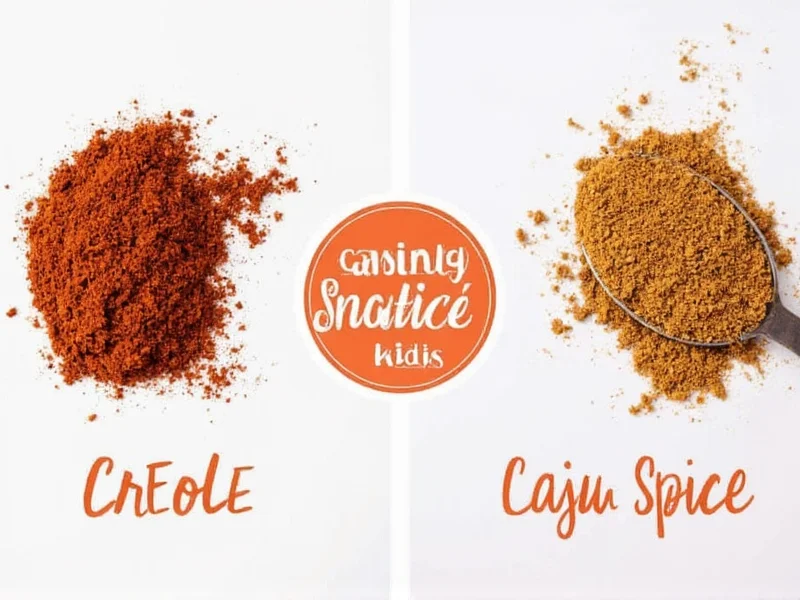Understanding the distinction between Creole and Cajun spice blends is crucial for authentic Louisiana cooking. While often confused or used interchangeably, these seasonings have unique flavor profiles rooted in different cultural histories. This comprehensive guide explores their origins, ingredients, flavor characteristics, and proper culinary applications to help you elevate your cooking with authentic Louisiana flavors.
Historical Origins: Two Culinary Traditions
The difference between Creole and Cajun spices begins with their distinct cultural backgrounds. Creole cuisine developed in urban New Orleans among descendants of French and Spanish colonists, African slaves, and Caribbean immigrants. This cosmopolitan environment created a more refined cooking style incorporating European techniques with tropical ingredients.
Cajun cuisine, by contrast, evolved from the rural Acadiana region among French settlers expelled from Canada (Acadie) who settled in Louisiana's bayous. Their "cuisine of the people" relied on available ingredients and one-pot cooking methods, resulting in heartier, spicier dishes.
Ingredient Comparison: What's Really in Each Blend
While recipes vary by manufacturer and family tradition, certain patterns distinguish authentic Creole and Cajun spice blends. The following table highlights the typical ingredient composition:
| Ingredient | Creole Spice | Cajun Spice |
|---|---|---|
| Cayenne Pepper | Moderate (15-25%) | High (30-40%) |
| Paprika | High (25-35%) | Moderate (15-25%) |
| Garlic Powder | Moderate | High |
| Onion Powder | Moderate | High |
| Oregano | High | Low or absent |
| Thyme | High | Low or absent |
| Black Pepper | Moderate | Moderate |
| White Pepper | Often included | Rarely included |
| Bay Leaf (ground) | Common | Less common |
Flavor Profile Analysis
Creole spice delivers a more complex, layered flavor profile with its prominent herb content. The paprika provides color and subtle sweetness, while oregano and thyme contribute earthy, floral notes. This creates a well-rounded seasoning suitable for dishes where you want flavor complexity without overwhelming heat.
Cajun spice, by contrast, emphasizes heat and earthiness. With higher cayenne content and less herbal influence, it delivers a more direct, fiery punch. The garlic and onion powders provide savory depth, but the overall profile remains hotter and more straightforward than Creole seasoning.
Culinary Applications: When to Use Each Blend
Understanding when to use Creole versus Cajun spice can transform your Louisiana-inspired dishes:
Use Creole spice when:
- Preparing seafood dishes like shrimp étouffée or crawfish bisque
- Seasoning tomato-based sauces for dishes like shrimp Creole
- Creating dressings for Louisiana-style salads
- Seasoning poultry where you want herbal complexity
- Adding depth to Creole dishes like gumbo (New Orleans style)
Use Cajun spice when:
- Preparing rustic one-pot dishes like Cajun gumbo
- Seasoning grilled or blackened meats, especially chicken and pork
- Creating spicy rice dishes or jambalaya
- Adding heat to game meats or sausages
- Preparing dishes where you want prominent heat without herbal notes
Common Misconceptions Clarified
Several myths persist about Creole and Cajun spices that deserve clarification. Many believe the only difference is heat level, but the herb content creates fundamentally different flavor profiles. Others think Creole is always milder, but some Creole blends can be quite spicy depending on the cayenne content.
Another misconception is that these terms are strictly regional. While their origins are geographical, modern usage has blurred these lines. Authentic Louisiana cooks understand the distinctions, but commercial blends often use the terms interchangeably for marketing purposes.
Creating Authentic Homemade Blends
For the most authentic experience, make your own spice blends. Here are traditional ratios:
Classic Creole Spice Blend:
- 3 parts paprika
- 2 parts garlic powder
- 2 parts onion powder
- 2 parts dried oregano
- 2 parts dried thyme
- 1 part cayenne pepper
- 1 part black pepper
- 1 part white pepper
- ½ part ground bay leaf
Traditional Cajun Spice Blend:
- 4 parts paprika
- 2 parts garlic powder
- 2 parts onion powder
- 2 parts black pepper
- 2 parts cayenne pepper
- 1 part dried thyme
- 1 part dried oregano (optional, minimal)
- 1 part ground white pepper
Store both blends in airtight containers away from light and heat. Properly stored, they'll maintain peak flavor for 3-4 months. For deeper flavor, toast whole spices before grinding them into your homemade creole seasoning or cajun seasoning blend.
Regional Variations and Modern Interpretations
Within Louisiana, regional variations exist. New Orleans Creole blends might include additional herbs like parsley, while blends from the Acadiana region might feature more local peppers. Modern interpretations sometimes incorporate ingredients like celery seed or mustard powder, though purists consider these non-traditional.
When shopping for commercial blends, look for products that list specific ingredients rather than "spice blend" to ensure authenticity. The best cajun spice blends for chicken will have higher garlic content, while optimal creole spice for seafood emphasizes paprika and herbs.
Conclusion: Mastering Louisiana Seasoning
Distinguishing between Creole and Cajun spices isn't just about heat levels—it's understanding two distinct culinary traditions. Creole seasoning offers herbal complexity ideal for seafood and tomato-based dishes, while Cajun seasoning delivers bold heat perfect for rustic meat preparations. By recognizing these differences and using each appropriately, you'll create more authentic Louisiana flavors in your kitchen. Whether you're preparing traditional cajun chicken recipes or authentic creole seafood dishes, choosing the right spice blend makes all the difference in achieving genuine regional flavors.











 浙公网安备
33010002000092号
浙公网安备
33010002000092号 浙B2-20120091-4
浙B2-20120091-4